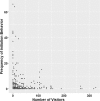Social and Reproductive Behavior of Captive Malayan Tapirs' (Tapirus indicus): Interactions with Maternal Experience and Environmental Conditions
- PMID: 32139707
- PMCID: PMC7058076
- DOI: 10.1038/s41598-020-60429-0
Social and Reproductive Behavior of Captive Malayan Tapirs' (Tapirus indicus): Interactions with Maternal Experience and Environmental Conditions
Abstract
Malayan tapirs are listed as endangered and are bred in captivity under governmental management. The success of captive breeding programs varies and the underlying causes are unclear. Here, we investigate how tapir reproduction is affected by previous breeding experience, enclosure type/size and visitor numbers so that appropriate steps can be taken to achieve self-sustaining captive populations. Data on social and reproductive behaviors were collected from six tapirs (three males, three females), from different breeding centers in Peninsular Malaysia for 18 weeks. Results revealed that social and reproductive behavior of both sexes was significantly influenced by social and environmental conditions. Larger enclosure size tended to increase social and reproductive behaviors, whereas high number of visitors reduced initial interaction between males and females. No specific breeding month was confirmed; however, reproductive behaviors were highest in April. Overall, this study contributes to a better understanding of the relationships between social and reproductive behaviors, and captive environments on Malayan tapirs. In future, frequency of sexual interactions should be monitored regularly to identify animals exhibiting below-average frequency and who might, therefore, be prone to reproductive difficulties.
Conflict of interest statement
The authors declare no competing interests.
Figures




References
-
- Mahler AE. Activity budgets and use of exhibit space by South American tapir (Tapirus terrestris) in a Zoological Park setting. Zoo. Biol. 1984;3:35–46. doi: 10.1002/zoo.1430030105. - DOI
-
- Read B. Breeding and management of the Malayan tapir: at St Louis Zoo. Int. Zoo. Yearbook. 1986;24:294–297. doi: 10.1111/j.1748-1090.1985.tb02557.x. - DOI
-
- Barongi RA. Husbandry and conservation of tapirs Tapirus spp. Int. Zoo. Yearbook. 1993;32:7–15. doi: 10.1111/j.1748-1090.1993.tb03508.x. - DOI
-
- Williams KD, Petrides GA. Browse use, feeding behavior and management of Malayan Tapir. J. Wildl. Manag. 1980;44:489–494. doi: 10.2307/3807985. - DOI
-
- Traeholt, C. et al. Tapirus indicus. The IUCN Red List of Threatened Species 2016: e.T21472A45173636. 10.2305/IUCN.UK.2016-1.RLTS.T21472A45173636.en (2016).
Publication types
MeSH terms
LinkOut - more resources
Full Text Sources
Miscellaneous

